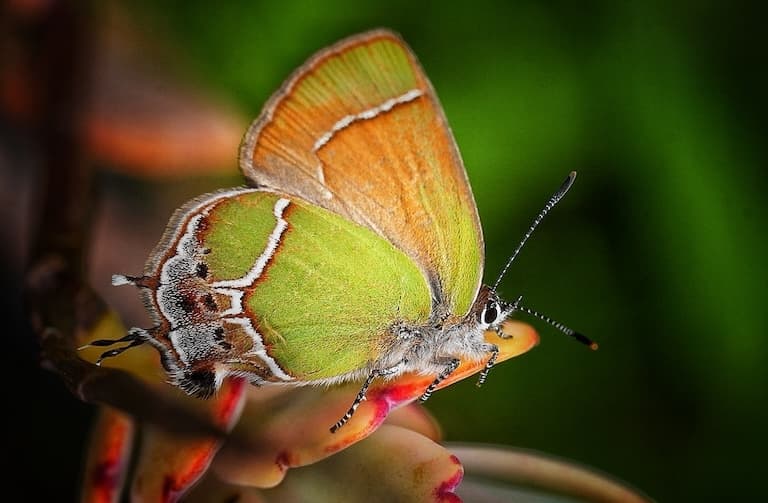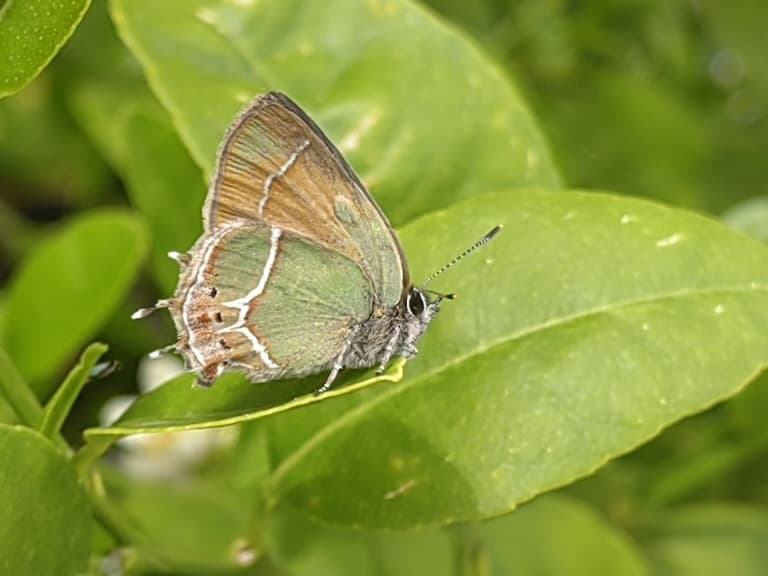Xami Hairstreak Profile
In Mexico City, the oldest capital city in the New World, there is a species of butterfly that brings with it the real Chilango attitude, despite being made of less than paper.
This species, like the capital itself, has a rich and fascinating history, not least in that Xami Hairstreak was discovered by a 19th-century entomologist with a life similar to these little insects themselves: short and tumultuous.

Xami Hairstreak Facts Overview
| Habitat: | Found around succulents, tropical and subtropical regions, and high altitudes |
| Location: | Mostly Mexico, either side of the border |
| Lifespan: | Unknown |
| Size: | Up to 2.9 cm (1.1 in) wingspan |
| Weight: | Imperceptible |
| Colour: | Greenish-brown underwings; brown upperparts; larva is mostly green |
| Diet: | Succulents, nectar |
| Predators: | Birds, bats, and lizards |
| Top Speed: | It’s a butterfly |
| No. of Species: | 1 |
| Conservation Status: | Not Listed |
This pretty little butterfly is a member of a confusing genus of animals whose taxonomy is yet to be properly worked out.
Not much is known about this one in particular, but it’s possible that, like its close relatives, its babies glow in the dark and farm ants; and like its discoverer, it may flee its home country and live in relative obscurity until it dies a mystery!
Interesting Xami Hairstreak Facts
1. “Cute as a bug’s ear”
Butterfly people have to employ some level of cognitive dissonance to function within the reality that a butterfly is, in fact, a caterpillar that can now also flap about in your face. But once this compartmentalism has been established, they are free to gush, and gush they most certainly do! It’s endearing to listen to lepidopterists talk about their passion. Well, sometimes it crosses into the uncomfortably obsessive, but for the most part, it’s nice.
The Xami hairstreak is the focus of just such a gushing, and being a delicate, rare, and pretty little thing, it receives all the praise of a proud dad introducing his daughter to the world.
The Xami hairstreak is really quite rare in the US, so gushing is intensified when it’s found there, and this one in particular has been described by Butterfly expert Christopher Kline as “Cute as a bug’s ear”1.

3. Their populations aren’t well known
There are many hairstreaks, but the genus as a whole hasn’t been finalised as monophyletic, meaning it still contains unrelated species too that have yet to be sorted out.
Hairstreaks are found in the Americas, but also in Asia and Europe, though the Xami is predominantly a Mexican species.
Being flighted animals (and given that insects have proven time and time again that they have no regard for our national boundaries), they will also be found in the US, close to the Mexican border, and down as far as Guatemala. This results in multiple populations, many of which are very small and very rare.
Some in South Texas have also been totally extirpated2.
2. They’re sticky
Speaking of caterpillars, as the lumbering, inelegant juvenile stages of the more highly-appraised butterfly, these are generally overlooked, despite the fact that they make up the vast majority of the animal’s life. The adult stage, the butterfly itself, is more or less a flapping set of caterpillar ‘nads whose sole responsibility is to drink enough sugar water to stay alive long enough to copulate with its corresponding set of flapping gonads.
And so, this flappy, mountain-dew-swilling neckbeard gets all the attention, and its working-class-hero larva really doesn’t deserve the hate.
Hairstreak caterpillars are nothing much to look at. They’re a bit fuzzier than your average grub, and recognisable by their ridged backs. In the Xami, they’re yellowish-green and a bit spiky. And in classic Lepidopterist fashion, they’re mostly unreported.
Yet hairstreak caterpillars in general are known for bribing ants with honeydew for protection. They do this by secreting a sticky substance that the ants really love. Suddenly, this unassuming little larva is surrounded by well-armoured bodyguards with an incentive to keep it alive.
Many larvae from the hairstreak clan glow under UV light, which is emerging as a strategy for the environmental monitoring folks in the UK to find them in the dark.
It’s not clear whether the Xami hairstreak larvae do either of these things, but that’s only because of a lack of data3.
4. They’re not listed
This species – and, indeed, all species in the genus – are not yet listed on the IUCN, for example. There isn’t nearly as much of a following in Mexico and Central America for flapping caterpillars as there is in the US, so they are also relatively understudied there, at least in English-language literature.
From a study in the ‘60s, they were reported as the only Haristreak species that thrives inside the city limits of Mexico City, and this paper remains the most comprehensive assessment on the species’ life cycle in the primary literature.
But there is some information on the behaviour to be found elsewhere4.

5. They migrate
Alright, we might have gone a bit too hard earlier, on the adult stage of this particular insect. Butterflies are not only pretty, but some are fairly badass as well; this one included.
From July to September, December to January, and April to May, this species is seen flapping about with more intent than usual, migrating between feeding and breeding sites.
Unlike many of the more useless flying gonads, these ones can mate multiple times before dropping dead, and so will develop a sort of attitude problem to handle the competition.
Males are very territorial and will attack both rivals and anything larger that enters their airspace quite fervently, though of course, there’s a limit to how far fervency can get you when you’re made of condensed breath.
Still, for something that is essentially stained ether, this is a tough little critter and is respected for its scrappy little personality as much as its appearance.
6. Tryon Reakirt
The Xami Hairstreak was one of several species described by the deeply fascinating and mysterious (and most 19th-century-named) Tryon Reakirt.
The remarkable life of this enigmatic entomologist is worth its own essay, but in summary, here was a man who filled all the roles of The Breakfast Club in a single person: He was a businessman, an entomologist, a fraudster, an outlaw, and a published researcher.
William Henry Edwards, the widely respected entomologist who wrote The Butterflies of North America, described Reakirt as the most competent in his field. Other claims about him collecting butterflies in the Rockies have been shut down as “Utterly False” in later papers.
Sadly, in classic 19th-century fashion, Reakirt died at 27 from dysentery while on the run from the United States government. The date of his death remains lost to the ether, like a butterfly
His legacy remains in the Reakirt hairstreak, as well as a substantial proportion of the collection found in the Chicago Natural History Museum5.

Xami Hairstreak Fact-File Summary
Scientific Classification
| Kingdom: | Animalia |
| Phylum: | Arthropoda |
| Class: | Insecta |
| Order: | Lepidoptera |
| Family: | Lycaenidae |
| Genus: | Callophrys |
| Species Name: | Xami |
Fact Sources & References
- Kline (2015), “Butterfly Basics”,Butterfly Ridge.
- Reakirt (1867), “Xami Hairstreak”, Butterflies and Moths of North America.
- (2025), “The hunt for glow-in-the-dark caterpillars”, BBC.
- Ziegler & Escalante (1964), “OBSERVAnONS ON THE LIFE HISTORY OF CALLOPHRYS XAMI (LYCAENIDAE)”, Journal of the Lepidopterists’ Society.
- Brown (Year), “TRYON REAKIRT”, Journal of the Lepidopterists’ Society.
